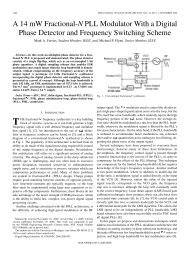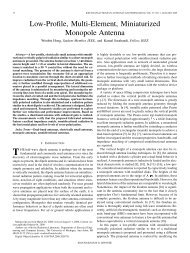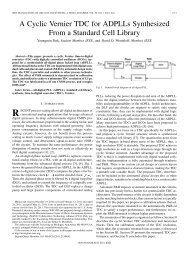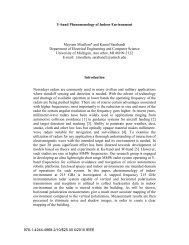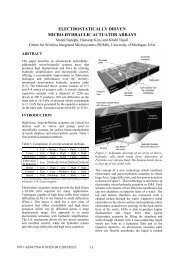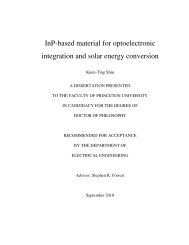www.ietdl.orglow-cost microfabrication techniques such as lithography [17,18]. However, in these techniques, the height of the<strong>waveguide</strong> is limited by the maximum thickness of the spunpho<strong>to</strong>resist, limiting the fabrication <strong>to</strong> the reduced-height<strong>waveguide</strong>s which suffer from high attenuation. Takingadvantage of the ‘snap-<strong>to</strong>gether’ technique, a <strong>rectangular</strong><strong>waveguide</strong> was fabricated in two halves and then the halveswere put <strong>to</strong>gether <strong>to</strong> form a complete <strong>waveguide</strong> [19–21].An alternate technique <strong>to</strong> etch the <strong>waveguide</strong> is deepreactive ion etching (DRIE) of silicon. Unlike wet etchingwhich is dependent on the crystal <strong>plane</strong>s of silicon, DRIE isisotropic and provides vertical sidewalls. Hence, DRIE is aviable approach for fabrication of a high-performancemicromachined <strong>waveguide</strong> structure. <strong>In</strong> [22, 23], a transitionusing microfabrication processes with separately fabricatedand assembled probe has been reported for both diamondand <strong>rectangular</strong> <strong>waveguide</strong> with 20% bandwidth. Anotherhigh-precision silicon micromachined transition with acapability <strong>to</strong> integrate filters has been proposed in [24, 25]and shows wideband characteristics at the same frequencyrange. However, limitations of microfabrication processesdo not allow fabricating many of the aforementionedtransitions because of the complexity of the geometriesand the number of steps needed in their assembly.<strong>In</strong> this study, we propose an in-<strong>plane</strong> <strong>cavity</strong>-<strong>backed</strong><strong>coplanar</strong> <strong>waveguide</strong> (CBCPW) line-<strong>to</strong>-<strong>rectangular</strong> <strong>waveguide</strong>transition with prismatic features that does not requiremultiple parts and complex assembly. <strong>In</strong> this approach, theneed for fabricating suspended probe is eliminated andeffective transition is achieved using two resonant structures,namely, shorted CPW line over the <strong>waveguide</strong> followed by anE-<strong>plane</strong> step discontinuity. Since the design is very simplewith the features aligned with the Cartesian coordinate <strong>plane</strong>s,it is highly compatible with microfabrication processes.However, it should be mentioned that since the design isusing short-circuited pin, the transition bandwidth issomewhat limited. The transition is modelled by an equivalentcircuit <strong>to</strong> help with the initial design which is then optimisedusing a full-wave analysis. To demonstrate the validity of thetransition and its model, a back-<strong>to</strong>-back structure is fabricatedby conventional machining methods at Ka-band and themeasurement results are compared <strong>to</strong> the simulations.1 Design considerations of <strong>waveguide</strong>transitionsTraditional transitions based on E-<strong>plane</strong> probe excitation ofthe <strong>waveguide</strong> mode involve attaching a suspended probe<strong>to</strong> the centre conduc<strong>to</strong>r of CPW or coaxial linesperpendicular <strong>to</strong> the broad wall of <strong>waveguide</strong>s as shown inFig. 1a. The suspended probes in <strong>waveguide</strong> can be viewedas an infinite array of dipoles and thus can be matched rathereasily <strong>to</strong> a coaxial line and provide octave bandwidth.The coaxial line-<strong>to</strong>-<strong>waveguide</strong> transitions are commonlyused at microwave frequencies since fabrication andassembly is rather straightforward. At high millimetre-waveand submillimetre-wave frequencies where dimensions arevery small, suspending small metalised probes and assemblywith the required <strong>to</strong>lerance is a challenging task. If the probeis extended, all the way <strong>to</strong> the lower plate of the <strong>waveguide</strong><strong>to</strong> form a shorting pin then the pin can be formed on samesubstrate and can be bonded <strong>to</strong> a <strong>to</strong>p substrate <strong>to</strong> make therequired electric connection. However, a short-circuitedprobe is not resonant, acts purely reactive and cannot bematched <strong>to</strong> the CPW line directly. <strong>In</strong> the next section, thearchitecture needed for making the transition from CPW <strong>to</strong><strong>rectangular</strong> <strong>waveguide</strong> using a shorting pin is described.2 Transition using a shorting pinTo properly excite a <strong>waveguide</strong> with a shorting pin, a resonantcondition must be achieved <strong>to</strong> eliminate the reactance of thepin. It is well known that a pin terminated by the broadwall of a <strong>rectangular</strong> <strong>waveguide</strong> acts as an inductiveelement whose inductance is inversely proportional <strong>to</strong> itsdiameter and the <strong>waveguide</strong> dimensions [26]. The geometryand the equivalent circuit model of a shorting pin areshown in Fig. 1b. For this case the transformer turn ratiocan be calculated from [27]√( )2a tan ka 2n =b ka(1)Fig. 1Design considerations of <strong>waveguide</strong> transitionsa Traditional resonant probe excitation for <strong>waveguide</strong>b Probe is terminated by the broad wall of the <strong>waveguide</strong>. <strong>In</strong> the equivalent circuit mode, L p is the equivalent inductance (X p ), C b is the series capacitance of theshort-circuited probe (X b ) [26] and Z 0 is the characteristic impedance of the <strong>waveguide</strong>c E-<strong>plane</strong> step discontinuity generates capacitances required for resonance needed for the mode conversion c the equivalent circuit model for the proposedresonanced The equivalent circuit model for the proposed resonance, X step is the equivalent capacitance of the step discontinuity444 IET Microw. Antennas Propag., 2012, Vol. 6, Iss. 4, pp. 443–449& The <strong>In</strong>stitution of Engineering and Technology 2012doi: 10.1049/iet-map.2011.0194
www.ietdl.orgwhere a and b are the width and height of the <strong>rectangular</strong><strong>waveguide</strong>, respectively, and k is the free spacewavenumber as described in [27]. The reactance X can beestimated by variational methods [27] and is capacitivebelow and inductive above the resonant frequency. Tocompensate for the inductance of the shorting pin X p , acapacitive element is needed. Since a step discontinuity inthe E-<strong>plane</strong> of the <strong>waveguide</strong> acts as a capacitive element, itcan be used <strong>to</strong> compensate for the inductive behaviour ofthe pin. That is, a resonant condition can be realised byterminating a short-circuited pin in a reduced-height<strong>waveguide</strong> with a step transition from the reduced-height<strong>waveguide</strong> <strong>to</strong> the standard-size <strong>waveguide</strong> as shown inFigs. 1c and d. The length of the <strong>waveguide</strong> between thepin and the step transition can be used <strong>to</strong> control thecapacitance seen by the inductance. Also, the <strong>waveguide</strong>height can be used <strong>to</strong> control the capacitance at the steptransition point. This structure eliminates the use ofsuspended probe for transition and is simple <strong>to</strong> fabricate.3 CBCPW <strong>to</strong> <strong>rectangular</strong> <strong>waveguide</strong>transitionCBCPW lines are preferred at very high frequencies formounting active components because of their low-losscharacteristics [28] (Fig. 2). Hence, a transition from alow-loss membrane-supported CBCPW <strong>to</strong> <strong>rectangular</strong><strong>waveguide</strong> is considered here. <strong>In</strong> this CBCPW, since thedielectric substrate is removed and the line is suspendedover a hollow trench, dielectric loss has been eliminated.Also, the conduc<strong>to</strong>r loss is decreased substantially byreducing the current density near the edges and distributingit more uniformly over the metallic strip and the groundaround it. For fabrication purposes, a dielectric membraneon <strong>to</strong>p of the line supports the suspended line over thetrench. This line can be easily incorporated with hollow<strong>rectangular</strong> <strong>waveguide</strong>s [28].To design the transition based on the idea of the shortcircuitedpin, first the dimensions of <strong>waveguide</strong> andCBCPW line are chosen based on the desired frequencyrange. The initial values of elements of the circuit modelare selected using the analytical formulas and measurementresults reported in [26, 27]. These values along with thelength of <strong>waveguide</strong> and CPW line sections are optimisedusing transmission line analysis of the circuit model <strong>to</strong>obtain the resonant behaviour. A structure based on thesevalues is designed and then optimised using full-wavesimula<strong>to</strong>r Ansoft HFSS.The proposed transition from CBCPW <strong>to</strong> <strong>rectangular</strong><strong>waveguide</strong> is presented in Figs. 3a and b. <strong>In</strong> this transition,three conversion steps are required: from CBCPW <strong>to</strong>conventional CPW inside the <strong>waveguide</strong>, CPW <strong>to</strong> reducedheight<strong>waveguide</strong> and reduced-height <strong>waveguide</strong> <strong>to</strong>standard <strong>waveguide</strong>. The CPW line is narrowed as it entersthe reduced-height <strong>waveguide</strong> in order <strong>to</strong> create atransmission line resona<strong>to</strong>r that includes the pin. A secondresona<strong>to</strong>r is created between the pin and the stepdiscontinuity inside the <strong>waveguide</strong>. The centre conduc<strong>to</strong>r ofthe CPW line is open circuited at the location of the pinand the pin is connected <strong>to</strong> the lower wall of a reducedheight<strong>waveguide</strong>. On the other side of the pin, thereduced-height <strong>waveguide</strong> is short circuited at a distance <strong>to</strong>appear as another reactance parallel <strong>to</strong> the pin inductance asshown in the equivalent circuit model in Fig. 3c. Thediscontinuity from CBCPW line <strong>to</strong> CPW line inside the<strong>waveguide</strong> is also modelled by a shunt capacitance.To demonstrate the performance of the proposed transitiona Ka-band pro<strong>to</strong>type is considered. The equivalent circuitmodel parameters are extracted as outlined before andthe S-parameters of a back-<strong>to</strong>-back structure from CBCPW<strong>to</strong> <strong>rectangular</strong> <strong>waveguide</strong> and <strong>rectangular</strong> <strong>waveguide</strong> <strong>to</strong>CBCPW based on the circuit model are shown in Fig. 3d.This design offers almost 9% of the bandwidth and lessthan 1 dB insertion loss. At the next step, Ansoft HFSS isused <strong>to</strong> analyse and optimise these values by adjustingthe lengths of transition line segments, the step height andthe pin thickness. The reflection coefficient of the optimisedstructure is compared <strong>to</strong> that of the circuit model for theback-<strong>to</strong>-back transition in Fig. 4. As shown, a goodagreement is obtained. It is also shown that the physicalstructure provides a better performance than the onepredicted by the circuit model. The electric field distributionof the optimised structure is shown in Fig. 5a andwell represents the conversion of the CPW mode <strong>to</strong>the <strong>waveguide</strong> mode using the terminated pin. Fig. 5brepresents the reflection and transmission coefficients of thistransition. It is observed that a transmission above 21 dBand reflection below 210 dB for more than 9% ofthe bandwidth can be achieved. An enlarged plot of thetransmission coefficient over the passband is also presentedin Fig. 5c.3.1 Bandwidth enhancementThe bandwidth of the transition is sufficient for mostapplication at these very high frequencies. However, insituations where more bandwidth is needed, the number ofshorting pins and step discontinuities can be increasedaccordingly.To add one more resonance, another shorting pin and stepdiscontinuity can be introduced. The geometry of a three-polestructure is shown in Fig. 6a. Since the height of the stepdiscontinuity is smaller which introduces smallercapacitance values, the pin must be thinner <strong>to</strong> provide aresonance value close <strong>to</strong> the previous ones. The dimensionsare optimised using Ansoft HFSS and the reflectioncoefficients of the structure are presented in Fig. 6b. Itisshown that the additional resonance increases the bandwidthup <strong>to</strong> about 15%.4 Fabrication and measurementFig. 2 Low-loss membrane supported <strong>cavity</strong>-<strong>backed</strong> CPW [28]<strong>In</strong> this line, the dielectric substrate is eliminated and the centre conduc<strong>to</strong>r issupported by a membrane on <strong>to</strong>p. The transition of this line <strong>to</strong> <strong>rectangular</strong><strong>waveguide</strong> is investigatedAs mentioned before, a dielectric membrane is used <strong>to</strong>support the <strong>to</strong>p suspended thin metal layer of CBCPW andprevent it from collapsing. The membrane covers theconduc<strong>to</strong>r and the structure cannot be fed by probes fromIET Microw. Antennas Propag., 2012, Vol. 6, Iss. 4, pp. 443–449 445doi: 10.1049/iet-map.2011.0194 & The <strong>In</strong>stitution of Engineering and Technology 2012



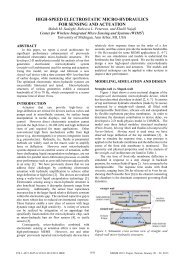
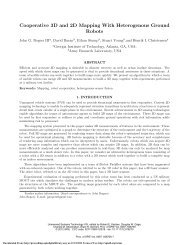
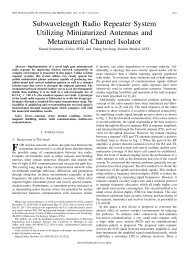
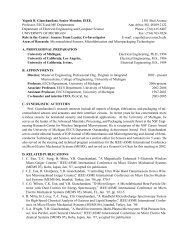
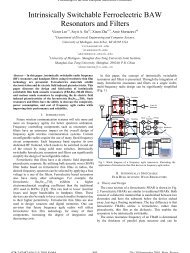
![[Sample B: Approval/Signature Sheet]](https://img.yumpu.com/34084789/1/190x245/sample-b-approval-signature-sheet.jpg?quality=85)
